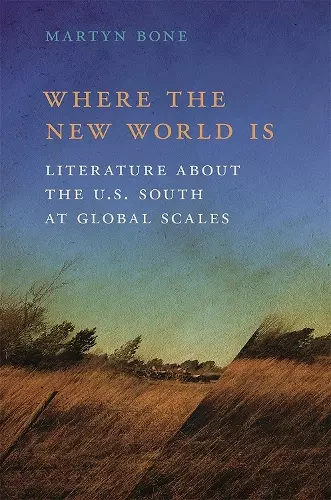Where the New World Is
Literature about the U.S. South at Global Scales
Format:Hardback
Publisher:University of Georgia Press
Published:15th Jan '18
Currently unavailable, currently targeted to be due back around 24th January 2025, but could change

How the humanities can help us understand globalization and immigration—the paramount realities in the twenty-first-century U.S. South
Assesses how fiction published since 1980 resituated the U.S. South globally and how earlier twentieth-century writing already had done so in ways traditional southern literary studies tended to ignore. Bone argues that this fiction has challenged understandings of the South as a fixed place largely untouched by immigration and globalization.
Where the New World Is assesses how fiction published since 1980 has resituated the U.S. South globally and how earlier twentieth-century writing already had done so in ways traditional southern literary studies tended to ignore. Martyn Bone argues that this body of fiction has, over the course of some eighty years, challenged received readings and understandings of the U.S. South as a fixed place largely untouched by immigration (or even internal migration) and economic globalization.
The writers discussed by Bone emphasize how migration and labor have reconfigured the region’s relation to the nation and a range of transnational scales: hemispheric (Jamaica, the Bahamas, Haiti), transatlantic/Black Atlantic (Denmark, England, Mauritania), and transpacific/global southern (Australia, China, Vietnam). Writers under consideration include Zora Neale Hurston, Nella Larsen, John Oliver Killens, Russell Banks, Erna Brodber, Cynthia Shearer, Ha Jin, Monique Truong, Lan Cao, Toni Morrison, Peter Matthiessen, Dave Eggers, and Laila Lalami.
The book also seeks to resituate southern studies by drawing on theories of “scale” that originated in human geography. In this way, Bone also offers a new paradigm in which the U.S. South is thoroughly engaged with a range of other scales from the local to the global, making both literature about the region and southern studies itself truly transnational in scope.
The southern question has never seemed so richly global as it does in Martyn Bone’s powerful new book Where the New World Is. Moving from original readings of Zora Neale Hurston and Nella Larsen to pioneering interpretations of Russell Banks and Monique Truong, Bone succeeds brilliantly in weaving together southern literary studies and post-national American studies. Americanists of all kinds will learn a great deal from this important work.
* author of Reconstructing the World: Southern Fictions and U.S. Imperialisms, 1898–1976 *Where The New World Is is the capstone of a generation's worth of scholarship on the American South, the Global South, and all points in between. More than that, it is a sharp-witted, gimlet-eyed exposé of a dazzling array of writers whose work pushes the South offshore. Bone does more than scramble your historic compass; he also leaves you with a sense of where we all need to go next. This book is the future of southern literary criticism.
* author of Seeing Race in Modern America *The book brilliantly dismantles enduring analytical tools, notably the black/white and North/South binaries. Bone also succeeds in demonstrating that the southern exceptionalism and regionalism have become irrelevant as a result of the transnational turn . . . while at the same time reaffirming the relevance of the South as a space of dialectical interaction between transnational, regional, and local scales.
* Journal of Southern History *Bone’s elegant writing is exhaustively researched and well argued. . . . Where the New World Is is an important and necessary book.
* ALH Online Review *Martyn Bone's Where The New World Is is the capstone of a generation's worth of scholarship on the American South, the Global South, and all points in between. More than that, it is a sharp-witted, gimlet-eyed exposé of a dazzling array of writers whose work pushes the South offshore. Bone does more than scramble your historic compass; he also leaves you with a sense of where we all need to go next. This book is the future of southern literary criticism.
* author of Seeing Race in Modern America *The book brilliantly dismantles enduring analytical tools, notably the black/white and North/South binaries. Bone also succeeds in demonstrating that the southern exceptionalism and regionalism have become irrelevant as a result of the transnational turn…while at the same time reaffirming the relevance of the South as a space of dialectical interaction between transnational, regional, and local scales.
* The Journal of Southern HistoISBN: 9780820351865
Dimensions: unknown
Weight: unknown
306 pages